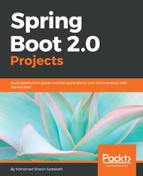The following code is the TaxiController, which caters to the registering, searching, status updating, and so on, of Taxis; it is available in spring-boot-2-taxi-service:
@RequestMapping("/taxis")
@RestController
public class TaxiController {
private final TaxiService taxiService;
public TaxiController(TaxiService taxiService) {
this.taxiService = taxiService;
}
@GetMapping
public Flux<TaxiAvailableResponseDTO>
getAvailableTaxis(@RequestParam("type") TaxiType taxiType,
@RequestParam("latitude") Double latitude, @RequestParam("longitude")
Double longitude, @RequestParam(value = "radius", defaultValue = "1")
Double radius) {
Flux<GeoResult<RedisGeoCommands.GeoLocation<String>>> availableTaxisFlux
= taxiService.getAvailableTaxis(taxiType, latitude, longitude, radius);
return availableTaxisFlux.map(r -> new
TaxiAvailableResponseDTO(r.getContent().getName()));
}
@GetMapping("/{taxiId}/status")
public Mono<TaxiStatusDTO> getTaxiStatus(@PathVariable("taxiId") String
taxiId) {
return taxiService.getTaxiStatus(taxiId).map(s -> new
TaxiStatusDTO(taxiId, s));
}
@PutMapping("/{taxiId}/status")
public Mono<TaxiStatusDTO> updateTaxiStatus(@PathVariable("taxiId") String
taxiId, @RequestParam("status") TaxiStatus taxiStatus) {
return taxiService.updateTaxiStatus(taxiId, taxiStatus).map(t -> new
TaxiStatusDTO(t.getTaxiId(), t.getTaxiStatus()));
}
@PutMapping("/{taxiId}/location")
public Mono<TaxiLocationUpdatedEventResponseDTO>
updateLocation(@PathVariable("taxiId") String taxiId, @RequestBody
LocationDTO locationDTO) {
return taxiService.updateLocation(taxiId, locationDTO).map(t -> new
TaxiLocationUpdatedEventResponseDTO(taxiId));
}
@PostMapping
public Mono<TaxiRegisterEventResponseDTO> register(@RequestBody
TaxiRegisterEventDTO taxiRegisterEventDTO) {
return taxiService.register(taxiRegisterEventDTO).map(t -> new
TaxiRegisterEventResponseDTO(t.getTaxiId()));
}
}
We can understand the following from the previous code:
- The getAvailableTaxis function is mapped to the URL /taxis and accepts taxi type, latitude, longitude, and radius in kilometers, and returns Taxis available in that geographical area
- The getTaxiStatus function is mapped to the URL /taxis/{taxiId}/status and returns the status of the Taxi identified by the taxiId path variable
- The updateTaxiStatus function is mapped to the URL /taxis/{taxiId}/status with the request method PUT and updates the status of the Taxi identified by the taxiId path variable
- The updateLocation function is mapped to the URL /taxis/{taxiId}/location with the request method PUT and updates the location of the Taxi identified by the taxiId path variable
- The register function is mapped to the URL /taxis with request method POST and registers a new Taxi into the system
The following code is TaxiBookingController, which caters to the registering, searching, status updating, and so on, of Taxis; it is available in spring-boot-2-taxi-book-service:
@RequestMapping("/taxibookings")
@RestController
public class TaxiBookingController {
private final TaxiBookingService taxiBookingService;
public TaxiBookingController(TaxiBookingService taxiBookingService) {
this.taxiBookingService = taxiBookingService;
}
@PostMapping
public Mono<TaxiBookedEventResponseDTO> book(@RequestBody TaxiBookedEventDTO
taxiBookedEventDTO) {
return taxiBookingService.book(taxiBookedEventDTO).map(t -> new
TaxiBookedEventResponseDTO(t.getTaxiBookingId()));
}
@PutMapping("/{taxiBookingId}/cancel")
public Mono<TaxiBookingCanceledEventResponseDTO>
cancel(@PathVariable("taxiBookingId") String taxiBookingId, @RequestBody
TaxiBookingCanceledEventDTO taxiBookingCanceledEventDTO) {
return taxiBookingService.cancel(taxiBookingId,
taxiBookingCanceledEventDTO).map(t -> new
TaxiBookingCanceledEventResponseDTO(t.getTaxiBookingId()));
}
@PutMapping("/{taxiBookingId}/accept")
public Mono<TaxiBookingAcceptedEventResponseDTO>
accept(@PathVariable("taxiBookingId") String taxiBookingId, @RequestBody
TaxiBookingAcceptedEventDTO taxiBookingAcceptedEventDTO) {
return taxiBookingService.accept(taxiBookingId,
taxiBookingAcceptedEventDTO).map(t -> new
TaxiBookingAcceptedEventResponseDTO(t.getTaxiBookingId(), t.getTaxiId(),
t.getAcceptedTime()));
}
@GetMapping
public Flux<TaxiBookingResponseDTO> getBookings(@RequestParam("type")
TaxiType taxiType, @RequestParam("latitude") Double latitude,
@RequestParam("longitude") Double longitude, @RequestParam(value = "radius",
defaultValue = "1") Double radius) {
return taxiBookingService.getBookings(taxiType, latitude, longitude,
radius).map(r -> new TaxiBookingResponseDTO(r.getContent().getName()));
}
}
We infer the following from the previous code:
- The book function is mapped to the URL /taxibookings with request method POST and creates a Taxi booking for a particular Taxi type with start and end location
- The cancel function is mapped to the URL /taxibookings/{taxiBookingId}/cancel and cancels a Taxi booking identified by the taxiBookingId path variable
- The accept function is mapped to the URL /taxibookings/{taxiBookingId}/accept and enables a driver to accept a Taxi booking identified by the taxiBookingId path variable
- The getBookings function is mapped to the URL /taxibookings and accepts taxi type, latitude, longitude, radius in a kilometers, and returns Taxi bookings available in that geographical area
